Please explain what was so indirect with my statement that you felt the need for this comment.So far these differences have only been alluded to.
Trying to trace back the conversation, firstly the velocity vs pressure source issue. How do you know you're not hearing something else?
For example (hypothetically), what about less activating of the transient response of the room walls? If that's it then it is not directly to do with velocity sources.
For example (hypothetically), what about less activating of the transient response of the room walls? If that's it then it is not directly to do with velocity sources.
Not sure which mode is being activated here but losses like that suggest not getting cabin gain inside the listening room. In a car, maybe, but a car is small.in the next room
It's a combination velocity/pressure source. Increasing the baffle makes it behave like two infinite baffle sources over a wider range.It's a velocity source
<snip>
many open baffle designs are LARGER than most sealed designs in an effort to keep the two poles from interacting
Well *velocity source in the context that I mentioned specifically referenced obvious mechanical and magnetic differences. The pressure in the cabinet literally changes/creates a derivation of Qm and to a far lesser extent Qe (which is also dependent on excursion).Trying to trace back the conversation, firstly the velocity vs pressure source issue. How do you know you're not hearing something else?
For example (hypothetically), what about less activating of the transient response of the room walls? If that's it then it is not directly to do with velocity sources.
(*though really, from what I remember a velocity source could just be referenced acoustically as directional.)
Obviously this mechanical and electrical difference changes freq. response - so that's audible. Many designers are often designing for a certain quality factor to achieve a level of damping, in the case of an open baffle it's just the Qts of the driver itself (though if low enough perhaps some will think this is over-damped and might put some resistance in the circuit to lessen that). In any event it's commonly known to be audible.
This along with polar differences (including diffraction), reflected sound leakage through the cone (driver and absorptive material dependent), and of course pressure differences on the low-end due to cancellation, are what I originally referenced: none of it is at all controversial IMO.
How did I know I wasn't hearing something else? Though I can't be absolutely certain (it is subjective after all), I'm am certain (measured) that at the very least freq.s above 500 Hz were quite different between my large open baffle test and my large baffle sealed cabinet (same drivers, same eq./high-pass behavior) due to the rear "pole" from the open-baffle that the sealed design did not have: and still subjectively the sound was extremely similar. (..each set placed in the same location for listening were positioned about 4-5 feet from the "front" wall - plenty of reflection at higher freq.s for the open baffle's rear "pole".) I'm really not sure if this does or does not "align" with your hypothetical (..that was hard to read/"decipher").
The lowest mode in the room, and again - it very obviously interacts with a sealed sub as mentioned (..both rooms, HT and adjoining family room, are very large).Not sure which mode is being activated here but losses like that suggest not getting cabin gain inside the listening room. In a car, maybe, but a car is small.
Yes. Like.It's a combination velocity/pressure source. Increasing the baffle makes it behave like two infinite baffle sources over a wider range.
Still not the same result.
Realistically with velocity sources and their measured results in-room you could say they are only velocity sources to a few inches/centimeters at lower freq.s. just past the point of their null from the baffle's edge. (..in other words they effectively loose their directional behavior in-room at lower freq.s).
While Velocity source and Pressure source are real distinctions, it's not a distinction (in and of itself) to dwell on - instead look to secondary effects (as mentioned) relating to alterations in driver operation when in an enclosure.
The choice to dampen hits a broad range of frequencies. I often wonder if the cure is worse than the disease.You damp that in the box so there isn't an issue.
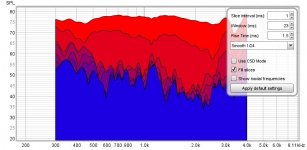

Here is the decay of the same model driver in two different boxes. One box has a bunch of stuff in it to damp and the other has nothing. When there is nothing the speaker can stop faster at some frequencies but has resonances. With 4" of melamine 4" from the back wall and stuffing behind that, I can zap it. But if you look at 800hz-2khz there is an added delay in the decay.
Yes. I think moving forward we should assume that everything has been equalised according to some scheme that allows a fair comparison of other relevant things.Obviously this mechanical and electrical difference changes freq. response - so that's audible.
Take a closed box. The 0th mode is a pressure mode in the box at low frequencies, where the cabinet breathes with the cone. The wall's natural reaction to being pushed away from its resting position is to come back at its own natural resonance frequency. Such a condition could be the cause of such things as one note bass, or be blamed for such things as a room mode.with your hypothetical (..that was hard to read/"decipher").
Yes, but that's ok for two reasons. One is that while a resonance is a wide band thing, outside its nominal bandwidth the levels become less significant.The choice to dampen hits a broad range of frequencies.
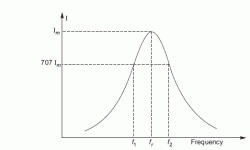
The other thing is that it's OK for the damping to absorb the resonance a little. The damping really works hardest at higher frequencies. After all, you can't fit more damping into the box where it's dimensions themselves are connected with the modes.
It's reasonably smooth, so I wonder if it's because of the scales?there is an added delay in the decay.
It's hard to say whether those resonances low down weren't hiding during the other shot too and have been uncovered. It's also uncertain whether they are related to the box modes. In any case they're a fair way down.
Last edited:
These two graphs are miles apart... one is smoothed at 1/6 and the other at 1/24, the scale is different and the timing settings (window, rise time) are different too.The choice to dampen hits a broad range of frequencies. I often wonder if the cure is worse than the disease. View attachment 1055620View attachment 1055621
Here is the decay of the same model driver in two different boxes. One box has a bunch of stuff in it to damp and the other has nothing. When there is nothing the speaker can stop faster at some frequencies but has resonances. With 4" of melamine 4" from the back wall and stuffing behind that, I can zap it. But if you look at 800hz-2khz there is an added delay in the decay.
Not quite telling a useful story this way. No way of knowing how clean those windows are at 23 ms or even worse 30 ms, what are we looking at? If it's a measurement
from within a room, there's quite a bit of 'room' in the pictures here already. I'd bet we're not looking at the results of the driver + box here by itself, isolated from other factors.
Someone new to this hobby reading this thread would not believe one can put a driver in a box and obtain a good result... 😳
...Someone new to this hobby reading this thread would not believe one can put a driver in a box and obtain a good result... 😳
Hopefully not - though hopefully it'll alert would-be box-speaker builders to what needs to be done internally for best results. 🙂
Well, I could say express the same hope about the outside of an enclosure, yet the enclosures with sharp corners still seem to dominate both the DIY as well as commercial builds..
Well, we are on the 5th page of this discussion, and it dawned on me to just do a basic search, in hopes to answer the OP.
In a nutshell:
Do woofers need an enclosure?

Subwoofers should not be used without a box as they require an enclosure to balance the front and back frequencies that are emitted. Using a subwoofer without a ported or sealed box can result in negligible sound.
In a nutshell:
Do woofers need an enclosure?
Subwoofers should not be used without a box as they require an enclosure to balance the front and back frequencies that are emitted. Using a subwoofer without a ported or sealed box can result in negligible sound.
But the thread is not about subwoofers.
Its about midbass in general and midrange coloration.
OP asked about sources of coloration.
I do not think your google search answered any of that.
Its about midbass in general and midrange coloration.
OP asked about sources of coloration.
I do not think your google search answered any of that.
Last edited:
Interesting point though, because the original question wasn't how do they compare in and out of a box. When boxes were invented, nude dipoles weren't even a thing 😀
In very first sentence OP talks about the same midbass in free air and in sealed box. Please read it and explain.Interesting point though, because the original question wasn't how do they compare in and out of a box. When boxes were invented, nude dipoles weren't even a thing 😀
Last edited:
Interesting point though, because the original question wasn't how do they compare in and out of a box. When boxes were invented, nude dipoles weren't even a thing 😀
Yes, and it's worth mentioning too that, at frequencies lower than a value determined by the driver's diameter, acoustic output declines at a rate of 6dB per octave (in free air). So, bass tends to disappear unless EQ'd at a rate of 6dB/octave to compensate.
(Assumes a driver with flat response when in an infinite baffle.)
Well, we are on the 5th page of this discussion, and it dawned on me to just do a basic search, in hopes to answer the OP.
In a nutshell:
Do woofers need an enclosure?
Subwoofers should not be used without a box as they require an enclosure to balance the front and back frequencies that are emitted. Using a subwoofer without a ported or sealed box can result in negligible sound.
Midrange coloration and subwoofer are separate and unrelated.
Here's a few ideas as to how you can absorb the sound radiating from the rear of the speaker cone. When I was starting out making speakers, I tried a driver ( with a weight behind the magnet to reduce mechanical vibration ) in un-stuffed boxes, and the boxy echo was awful so ever since I've don my best to reduce the effect.
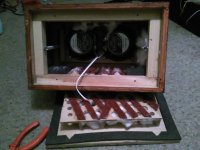
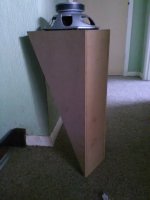
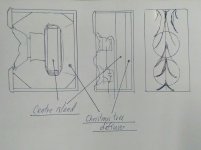



My oversight. Apologies offered. He did say something about bass/mid-bass. It was the first google search result I used. There are many more which explain why using an enclosure is generally accepted as a preference to the absence of one. I do realize that stance does not bode well in these DIY pages. So be it.Midrange coloration and subwoofer are separate and unrelated.
No worries. You and me are not going to solve this thread. Issue is quite complex and solutions are many. Many ways to skin the cat.
Some hate free air speakers, some love it. I am ok with it. Some like closed or ported woofers. Some hate closed box woofers and preffer open baffle of some sort, u shape, h shape, zigzag, you name it. I am ok with it.
Some hate free air speakers, some love it. I am ok with it. Some like closed or ported woofers. Some hate closed box woofers and preffer open baffle of some sort, u shape, h shape, zigzag, you name it. I am ok with it.
I believe the enclosure and driver become a coupled system with significant complexity of interaction between the two depending on how well they compliment each other. I dont always see a specific benefit of either coupling or decoupling the driver mechanically from or to the enclosure, especially with a dedicated midbass driver.
With regards to dampening materials, I find that Dacron (polyfill) is inferior to many others and sometimes it can make things worse at certain frequencies compared to sheep's wool or mineral wool. In some cases you can go too far with just minimal excess amounts of dampening, especially with a 2 way or fullrange setup. There almost always is a tradeoff between doing whats best for bass and hurting the midrange. To my ears, focussing on diffusing the rear wave rather than absorbing it (and converting to heat) sounds better, but the complexity in enclosure design is prohibitive and can't easily be altered if you want to experiment.
For controlling midrange frequencies, sheep's wool typically works best in the right amount, but by far the best approach is to design the enclosure in a way there are few parallel walls or other surfaces which directly can reflect energy into the back of the driver's cone. This is especially the case with drivers that have thinner cones and are played much louder than usual.
With regards to dampening materials, I find that Dacron (polyfill) is inferior to many others and sometimes it can make things worse at certain frequencies compared to sheep's wool or mineral wool. In some cases you can go too far with just minimal excess amounts of dampening, especially with a 2 way or fullrange setup. There almost always is a tradeoff between doing whats best for bass and hurting the midrange. To my ears, focussing on diffusing the rear wave rather than absorbing it (and converting to heat) sounds better, but the complexity in enclosure design is prohibitive and can't easily be altered if you want to experiment.
For controlling midrange frequencies, sheep's wool typically works best in the right amount, but by far the best approach is to design the enclosure in a way there are few parallel walls or other surfaces which directly can reflect energy into the back of the driver's cone. This is especially the case with drivers that have thinner cones and are played much louder than usual.
- Home
- Loudspeakers
- Multi-Way
- Why does a drive unit sound so different when placed in an enclosure?